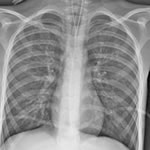Case history
Case history #1
An 8-year-old boy with a history of asthma presents with wheezing and shortness of breath. There are no preceding upper respiratory tract symptoms or fever. His paediatrician prescribes oral corticosteroids, but before the prescription is filled the child suffers a respiratory arrest. He is resuscitated by paramedics and admitted to the paediatric intensive care unit in status asthmaticus. Systemic corticosteroids are given and he is intubated after non-invasive positive pressure ventilator support, continuous salbutamol, and magnesium sulphate therapy fails. A nasopharyngeal swab is positive for rhinovirus. Although there is concern that he will require extracorporeal life support, he responds to therapy and is extubated within 3 days. The respiratory isolate is sent to a reference clinical laboratory for viral sequence analysis, where the diagnosis of enterovirus D68 is confirmed. Concurrent to the child’s admission, numerous other children are admitted for treatment of asthma exacerbation or severe lower respiratory illnesses. [Figure caption and citation for the preceding image starts]: Chest x-ray of a child with EV-D68 intubated for status asthmaticusFrom the collection of Dr Charles B. Foster [Citation ends].
Case history #2
A 7-year-old boy presents with mild headache followed a day later by a low-grade fever, rhinorrhoea, and bilateral ear pain. He is prescribed amoxicillin/clavulanic acid for bilateral otitis media. Three days later, he develops acute onset left arm and leg weakness with trouble walking. There are no complaints of neck pain, numbness, tingling, urinary retention, or urinary/faecal incontinence. Neurological examination confirms a flaccid left hemiplegia with areflexia. An MRI of the spine shows a T2/STIR hyperintensity restricted to the ventral grey matter of the cervical and thoracic spinal cord. An MRI of the brain shows subtle non-enhancing T2/FLAIR signal involving the dorsal pons. Cerebrospinal fluid analysis shows pleocytosis with 90 × 10⁶ white blood cells/L (90% lymphocytes), normal protein and glucose, with slightly elevated CSF IgG synthesis and index. CSF culture and viral studies (including enterovirus) are negative. [Figure caption and citation for the preceding image starts]: MRI of the spine showing a T2/STIR hyperintensity restricted to the ventral grey matter of the cervical and thoracic spinal cord in a child with acute flaccid myelitis.From the collection of Neil Friedman, MBChB, Center for Pediatric Neurology, Cleveland Clinic, Cleveland, Ohio [Citation ends].
Other presentations
Most individuals infected with enterovirus D68 (EV-D68) have mild symptoms such as runny nose, cough, sneezing, or muscle aches; some patients have fever. During large outbreaks, many patients (particularly children) may seek treatment because of severe lower respiratory symptoms. Often patients with more severe disease have a history of asthma or chronic lung disease. Among children hospitalised with EV-D68-related respiratory disease, a large proportion require admission to an intensive care unit. Sudden deterioration requiring intubation is not uncommon.
Use of this content is subject to our disclaimer